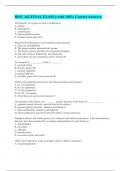Samenvatting
Summary Strategic Innovation Management
This is a complete summary of the course Strategic Innovation Management taught at KU Leuven, campus Brussels including complete notes from all classes. The course is part of the track module of the Master of Business Administration - Strategy, Innovation & Entrepreneurship.
[Meer zien]











